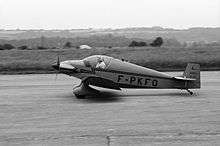Jodel D9
| D9 Bébé | |
|---|---|
 | |
| Role | Ultralight monoplane |
| National origin | France |
| Manufacturer | Jodel |
| Designer | Jean Délémontez |
| First flight | January 22, 1948 |
| Introduction | 1948 |
| Number built | 500+ |
| Unit cost |
approximately $2185 to build in 1971[1] |
| Variants | Falconar F9A |
The Jodel D.9 Bébé is a French single-seat ultralight monoplane designed by Jean Délémontez for amateur construction.[2]
Design and development
In March 1946, Edouard Joly and Jean Délémontez formed the Société des Avions Jodel to supply kits, materials and plans to allow homebuilders to construct an ultralight monoplane designed by Délémontez and named the Jodel D.9 Bébé . The D9 was a wooden low-wing cantilever monoplane with a single-seat open cockpit and a fixed tailskid landing gear. The wing had an inner section of parallel chord and no dihedral, joined to outer tapered sections with strong (140) dihedral,. This became a standard feature of many subsequent Jodel models. The prototype D.9, registered F-PEPF first flew on the 22 January 1948 flown by Edouard Joly.

The D.9 was powered by a single 25 h.p. Poinsard flat two-cylinder engine, the D.91 by a 34 h.p. A.B.C. Scorpion flat-two and the D.92 by flat-four Volkswagen engines of either 26 h.p. or 45 h.p.[3] The D.93 had a 35 h.p. Poinsard, the D.97 a 32 h.p. Sarolea Vautour and the D.98 a 25 h.p. AVA-40.[4]
Although designed for amateur construction and built in large numbers, it was also built commercially and the Wassmer company built 12. Plans were also sold by a number of companies including Falconair in Canada. Over 800 plans have been sold and over 500 aircraft have been built by amateurs and flying clubs.
Ben Keillor translated the French kit plans to English in 1959, and constructed and demonstrated a D9 in Canada and America.[5] The design was further developed into the two-seat Jodel D.11.
Jodel D.10
Jean Delmontez scaled up the D.9 to produce plans for a three-seater powered by a 75-85 hp engine, but was persuaded by SALS (the Light Sport Aircraft Service of the French Government) to build the two-seat D.11 to provide training aircraft for French aero clubs using the wing of the D.10.
Aircraft on display
- The prototype F-PEPF was displayed at the Musée de l'Air et de l'Espace, Paris, France, from 1962 to 2006[6]
Specifications (D92)
Data from [3]
General characteristics
- Crew: one
- Length: 5.45 m (17 ft 10.5 in)
- Wingspan: 7 m (22 ft 11 in)
- Wing area: 9.2 m2 (97 ft2)
- Empty weight: 162 kg (356 lb)
- Gross weight: 272 kg (598 lb)
- Powerplant: 1 × Volkswagen flat-four air cooled piston engine, 19 kW (26 hp) each
Performance
- Maximum speed: 150 km/h (93 mph)
- Cruising speed: 130 km/h (81 mph)
- Range: 460 km (286 miles)
- Rate of climb: 2.1 m/s (412 ft/min)
See also
- Related development
References
Notes
- ↑ Leo J. Kohn (Winter 1971). "The true cost of building your own plane". Air Trails: 63.
- ↑ Bayerl, Robby; Martin Berkemeier; et al: World Directory of Leisure Aviation 2011-12, page 31. WDLA UK, Lancaster UK, 2011. ISSN 1368-485X
- 1 2 JAWA
- ↑ Simpson
- ↑ Sport Aviation. August 1960. Missing or empty
|title=(help) - ↑ (French) Jodel "Bébé" D-9 n°01 F-PEPF
Bibliography
- Bridgman, L. Jane's all the world's aircraft 1956-7.London: JAWA publishing co. ltd.
- The Illustrated Encyclopedia of Aircraft (Part Work 1982-1985). Orbis Publishing.
- Simpson, R. Airlife's world aircraft (2001) Shrewsbury: Airlife Publishing Ltd. ISBN 1-84037-115-3.
External links
| Wikimedia Commons has media related to Jodel D9. |
- PFA Specification Sheet
- The Jodel D9 Bebe
- Avions Jodel - le D9 : le bébé Jodel - French page about the D9